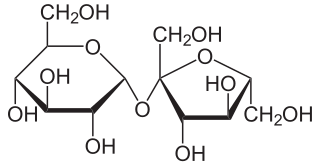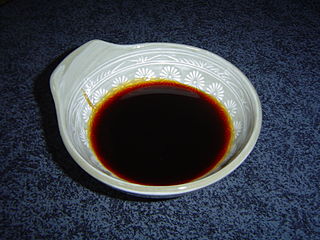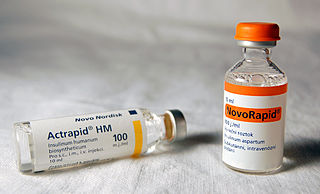

Pomegranate juice is made from the fruit of the pomegranate. It is used in cooking both as a fresh juice and as a concentrated syrup.


Pomegranate juice is made from the fruit of the pomegranate. It is used in cooking both as a fresh juice and as a concentrated syrup.
Various primary studies have been conducted into possible health benefits derived from drinking pomegranate juice, [1] but there is no good evidence to suggest any effect in blood pressure management, [2] glucose and insulin management, [3] or heart disease. [4]
Drug interactions are possible. [5]
Pomegranate juice was marketed by POM Wonderful, a pomegranate products manufacturer. As of September 2010, the company and its principals were the subjects of a false advertising complaint by the Federal Trade Commission (FTC). [6] In May 2012, after a hearing, the administrative law judge issued an opinion upholding certain false advertising allegations in the FTC's complaint—based on implied as opposed to express claims—and finding for POM Wonderful on other points. [7] As of May 24,2012 [update] , POM Wonderful's action in the U.S. District Court was pending consideration. [8] [ needs update ]

Pomegranate molasses is a fruit syrup made from pomegranate juice, not sugarcane-derived molasses. It is a reduction from the juice of a tart variety of pomegranate, evaporated to form a thick, dark red liquid. Pomegranate molasses is often used on top of meatloaf or meatballs to give them a shiny glaze and can be also be used for drizzling over rice pudding or oatmeal. It is used in Iranian fesenjān and Turkish dolma and various salads such as çoban salatası. [9]

Sugar is the generic name for sweet-tasting, soluble carbohydrates, many of which are used in food. Simple sugars, also called monosaccharides, include glucose, fructose, and galactose. Compound sugars, also called disaccharides or double sugars, are molecules made of two bonded monosaccharides; common examples are sucrose, lactose, and maltose. White sugar is a refined form of sucrose. In the body, compound sugars are hydrolysed into simple sugars.

Fructose, or fruit sugar, is a ketonic simple sugar found in many plants, where it is often bonded to glucose to form the disaccharide sucrose. It is one of the three dietary monosaccharides, along with glucose and galactose, that are absorbed by the gut directly into the blood of the portal vein during digestion. The liver then converts both fructose and galactose into glucose, so that dissolved glucose, known as blood sugar, is the only monosaccharide present in circulating blood.

Sucrose, a disaccharide, is a sugar composed of glucose and fructose subunits. It is produced naturally in plants and is the main constituent of white sugar. It has the molecular formula C
12H
22O
11.

Orange juice is a liquid extract of the orange tree fruit, produced by squeezing or reaming oranges. It comes in several different varieties, including blood orange, navel oranges, valencia orange, clementine, and tangerine. As well as variations in oranges used, some varieties include differing amounts of juice vesicles, known as "pulp" in American English, and "(juicy) bits" in British English. These vesicles contain the juice of the orange and can be left in or removed during the manufacturing process. How juicy these vesicles are depend upon many factors, such as species, variety, and season. In American English, the beverage name is often abbreviated as "OJ".

Molasses is a viscous byproduct, principally obtained from the refining of sugarcane or sugar beet juice into sugar. Molasses varies in the amount of sugar, the method of extraction and age of the plant. Sugarcane molasses is usually used to sweeten and flavour foods. Molasses is a major constituent of fine commercial brown sugar.

Grenadine is a commonly used nonalcoholic bar syrup characterized by its deep red color. It is a popular cocktail ingredient renowned for its flavor as well as its ability to give a reddish or pink tint to mixed drinks. Grenadine was traditionally made from pomegranate but is more often encountered as a syrup made from elder, blackcurrant, raspberry, gooseberry or other berries and fruits.

The pomegranate is a fruit-bearing deciduous shrub in the family Lythraceae, subfamily Punicoideae, that grows between 5 and 10 m tall. The pomegranate is rich in symbolic and mythological associations in many cultures.

Golden syrup or light treacle is a thick, amber-coloured form of inverted sugar syrup made by the process of refining sugar cane or sugar beet juice into sugar. It is used in a variety of baking recipes and desserts. It has an appearance and consistency similar to honey, and is often used as a substitute where honey is unavailable.
POM Wonderful, LLC is a private company which sells an eponymous brand of beverages and fruit extracts. It was founded in 2002 by the billionaire industrial agriculture couple Stewart and Lynda Rae Resnick. Through The Wonderful Company, their holding company, they are also affiliated with Teleflora, FIJI Water, pesticide manufacturer Suterra, and Paramount Agribusiness. In 2010, the company was warned by the FDA for making false health claims and for marketing statements that promoted their products as unauthorized drugs.
Superfood is a marketing term for food claimed to confer health benefits resulting from an exceptional nutrient density. The term is not commonly used by experts, dietitians and nutrition scientists, most of whom dispute that particular foods have the health benefits claimed by their advocates. Even without scientific evidence of exceptional nutrient content, many new, exotic, and foreign fruits or ancient grains are marketed under the term – or superfruit or supergrain respectively – after being introduced or re-introduced to Western markets.

Agave syrup, also known as maguey syrup or agave nectar, is a sweetener commercially produced from several species of agave, including Agave tequilana and Agave salmiana. Blue-agave syrup contains 56% fructose as a sugar providing sweetening properties.

Date honey, date syrup, date molasses, Debes, or rub is a thick dark brown, very sweet fruit syrup extracted from dates. It is widely used in Middle Eastern cuisine and Maghrebi cuisine.

As a medication, insulin is any pharmaceutical preparation of the protein hormone insulin that is used to treat high blood glucose. Such conditions include type 1 diabetes, type 2 diabetes, gestational diabetes, and complications of diabetes such as diabetic ketoacidosis and hyperosmolar hyperglycemic states. Insulin is also used along with glucose to treat hyperkalemia. Typically it is given by injection under the skin, but some forms may also be used by injection into a vein or muscle. There are various types of insulin, suitable for various time spans. The types are often all called insulin in the broad sense, although in a more precise sense, insulin is identical to the naturally occurring molecule whereas insulin analogues have slightly different molecules that allow for modified time of action. It is on the World Health Organization's List of Essential Medicines. In 2021, it was the 179th most commonly prescribed medication in the United States, with more than 2 million prescriptions.
The Pomegranate Council is a non-profit agricultural commodity marketing organization based in Sonoma, CA.

Added sugars or free sugars are sugar carbohydrates added to food and beverages at some point before their consumption. These include added carbohydrates, and more broadly, sugars naturally present in honey, syrup, fruit juices and fruit juice concentrates. They can take multiple chemical forms, including sucrose, glucose (dextrose), and fructose.

Stewart Allen Resnick is an American billionaire businessman. In 2018, Resnick was the wealthiest farmer in the United States. Resnick and his wife, Lynda Resnick, bought The Franklin Mint in 1986 and sold it in 2006. Since 1979 Resnick has been the chairman and president of The Wonderful Company. He is married to Lynda Resnick, and through their holding company they own the POM Wonderful and Fiji Water brands, Wonderful Pistachios and Almonds, Wonderful Halos, Wonderful Seedless Lemons, JUSTIN Wines, Landmark Wines, JNSQ Wines and the Teleflora floral wire service company.

Grape syrup is a condiment made with concentrated grape juice. It is thick and sweet because of its high ratio of sugar to water. Grape syrup is made by boiling grapes, removing their skins, squeezing them through a sieve to extract the juice. Like other fruit syrups, a common use of grape syrup is as a topping to sweet cakes, such as pancakes or waffles.
POM Wonderful LLC v. Coca-Cola Co., 573 U.S. 102 (2014), was a United States Supreme Court case that held that a statutory private right of action under the Lanham Act is not precluded by regulatory provisions of the Food, Drug, and Cosmetic Act.